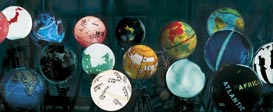Educators Programme Fact Sheet
Chair: Mark Chavez, Nanyang Technological University
Conference: Wednesday 10 December - Saturday 13 December
Exhibition: Thursday 11 December - Saturday 13 December
The Facts
- SIGGRAPH Asia 2008 Educators Programme is envisioned as an international gathering of industry professionals and academics; the Educators Programme presents perspectives that appeal to a wide spectrum of interests. The goal is to share educational strategies adopted in both industry and academia to make the learning process more satisfying, productive, and meaningful.
- Eighteen presentations are selected to be presented, with an additional five curated sessions, thus bringing the total number of presentations to be presented in the SIGGRAPH Asia 2008 Educators Programme this December to 22.
- The SIGGRAPH Asia 2008 Educators Programme promises content with Asian perspectives.
A Quote from the SIGGRAPH Asia 2008 Educators Programme Chair:
"Participating in the SIGGRAPH conferences has always been a pleasure. So with this in mind it's been great fun planning the Educators Programme for SIGGRAPH Asia 2008. I'm looking forward to meeting many of the people who submitted their research for the conference and am especially pleased
to have so many interested in submitting content to the Educators Programme. I'm glad to be part of this inaugural event."
SIGGRAPH Asia 2008 Educators Programme highlights include:
Educators Key Note Address: The New Perspective of Consilience of the Arts and Technology in the Era of Ubiquitous Computing
Park Se-Hyung
Korea National University of Arts
Bridging the Gap Between Education and Professional Production
This is an Educators Panel. As there is no professional certification for animators or visual effects professionals, it's time to move toward a universally acceptable framework for specifying and evaluating the skills, portfolios, and show reels that are the fundamental entry point to
prospective employment. Also, it's essential to blend this framework into every employee's upgrade path and lifelong learning plans in this rapidly evoloving field. The panelists have been dealing with these problems for many years, as educators, trainers, and recruiters. Their desire is to see dramatic improvement in education and training through development of clearly defined professional requirements. Such a framework will make it easier for institutions to design relevant and high-quality education that meets the needs of today's and tomorrow's globally distributed production companies.
Panelists
Robin King
Imagina Corporation
Prashant Buyyala
Rhythm & Hues Studios
Shelley Page
DreamWorks Animation
Michael Sehgal
Autodesk, Inc
Using Augmented Reality to Promote Understanding of Materials Science to School Children
Augmented reality (AR) is a relatively mature technology, but so far it remains largely undiscovered by schools as a means of enhancing traditional lesson delivery. The advantage of AR is its ability to overlay information on real physical objects as viewed on a LCD projector or interactive white board. This paper describes a set of educational AR software for helping children to familiarise themselves with simple physics, chemistry, and materials principles.
AR technology brings photographic and computer-generated images into real environments, facilitating real-time 3D interactions connected to physically available objects. The tools developed in this project comprise four major kinds of applications, each designed to help pupils learn about materials and their applications. The linkages between the hands-on materials and their properties and applications are explored through a series of puzzles, games, and tasks, with the AR providing intuitive guidance. The paper outlines development and deployment of AR and discusses evaluations that will be carried out with teachers and pupils during exhibitions at the Farnborough Air Show, the
Manchester Science Festival, and schools visits. The goal is to provide a valuable starting point for other AR developments in educational settings.
Authors
Kevin Tan
Emma Lewis
University of Manchester
Nick Avis
Cardiff University
Philip Withers
University of Manchester
Comparison of Animation Storyboard Education in China and the United States
More and more Chinese universities and schools have started teaching animation storyboard courses, but there is still a shortage of original work produced by
the Chinese animation industry. This panel discusses the development of Chinese animation storyboard education and compares it to similar programmes in the US. The result is new insight into how to most effectively teach animation storyboarding. The inquiry focuses, in part, on development of story and visual content, and how storyboard artists develop concepts. Animation storyboard programmes are compared through an examination of their curricula, faculty, 2D and 3D computer animation works, lab facilities, environmental and aesthetic aspects, and contrasts between the two cultures. Practical approaches to teaching are also discussed. The goal of this presentation is to provide an
international perspective on animation storyboard education and a summary of the current state of Chinese animation.
Panelists
Hui Zhu
Xiaobo Lu
Tsinghua University
Frank Suarez
Bunko Studios, Inc.









